Abstract
A tissue culture cell system for isolation and identification of members of the murine leukemia virus group (the complement fixation for murine leukemia test) was modified to permit the isolation of naturally occurring virus from leukemic and normal mice. The important factors for increasing the sensitivity of the test were the use of National Institutes of Health (NIH) strain Webster Swiss embryo cell cultures and the selection of rat-immune sera having complement-fixing antibodies to tissue culture antigens of both the Gross and FMR subgroups. In all, 163 strains of mouse leukemia virus, from 11 inbred mouse strains, have been isolated. Representative virus isolates were shown to possess the properties of the murine leukemia virus group; i.e., they were chloroform-sensitive, noncytopathic agents which replicated in mouse embryo tissue culture and produced group-reactive, complement-fixing antigen and budding C-type particles visible by electron microscopy. These viruses could serve as helpers in the rescue of Moloney sarcoma virus genome from non-producer hamster sarcoma cells, yielding pseudotypes. All of the 19 field isolates tested were neutralized by Gross passage A antiserum but not by potent antisera to the Moloney, Rauscher, and Friend strains. Virus was recovered regularly from embryos and from the plasma and spleen of adult mice of high leukemic strains. In low leukemic mouse strains, different patterns of virus detection were observed. In C3H/He mice, virus was occasionally present in embryos and was found in 40% of adult spleens. BALB/c mice were virus-negative as fetuses or weanlings, but spleens of more than half of the mice over 6 months of age yielded virus. NIH mice have never yielded virus. In reciprocal matings between AKR and BALB/c mice, virus recovery from embryos was maternally determined. The development of tissue culture isolation procedures made possible for the first time the application of classical infectious disease methods to the study of the natural history of murine leukemia virus infection.
Full text
PDF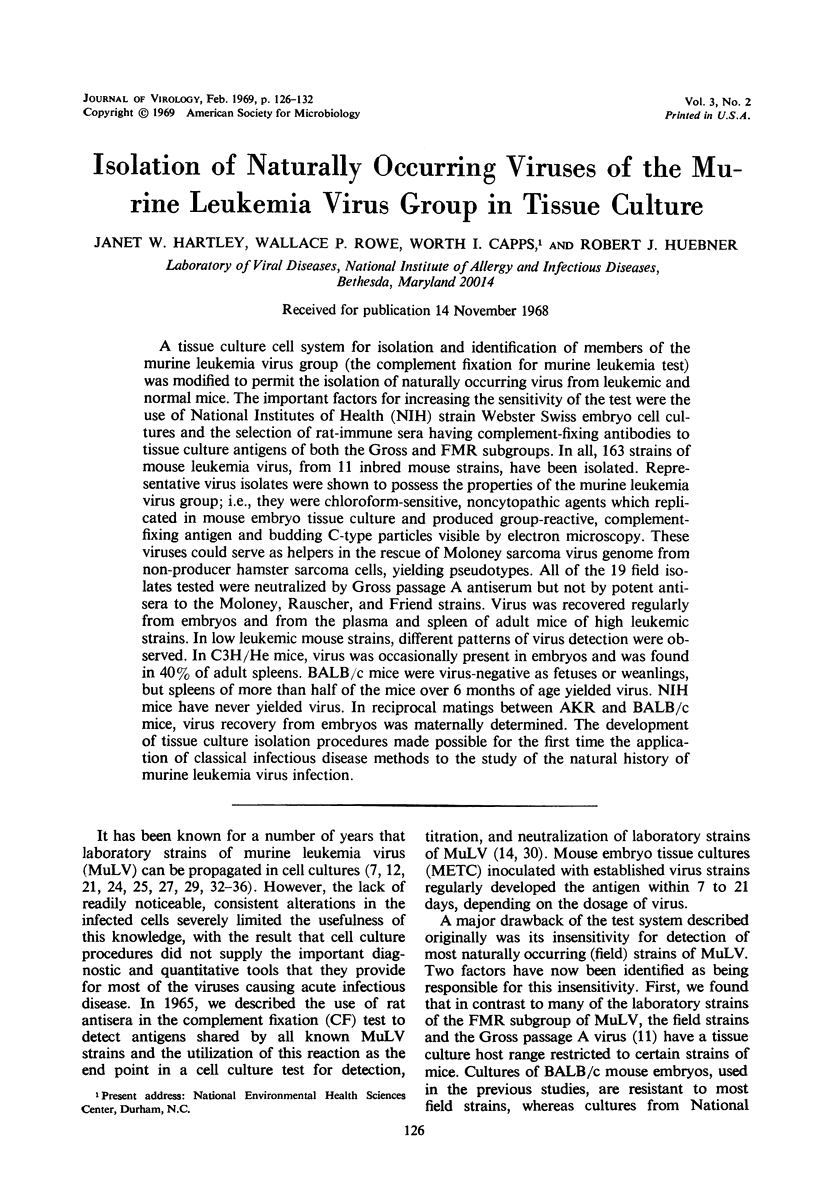
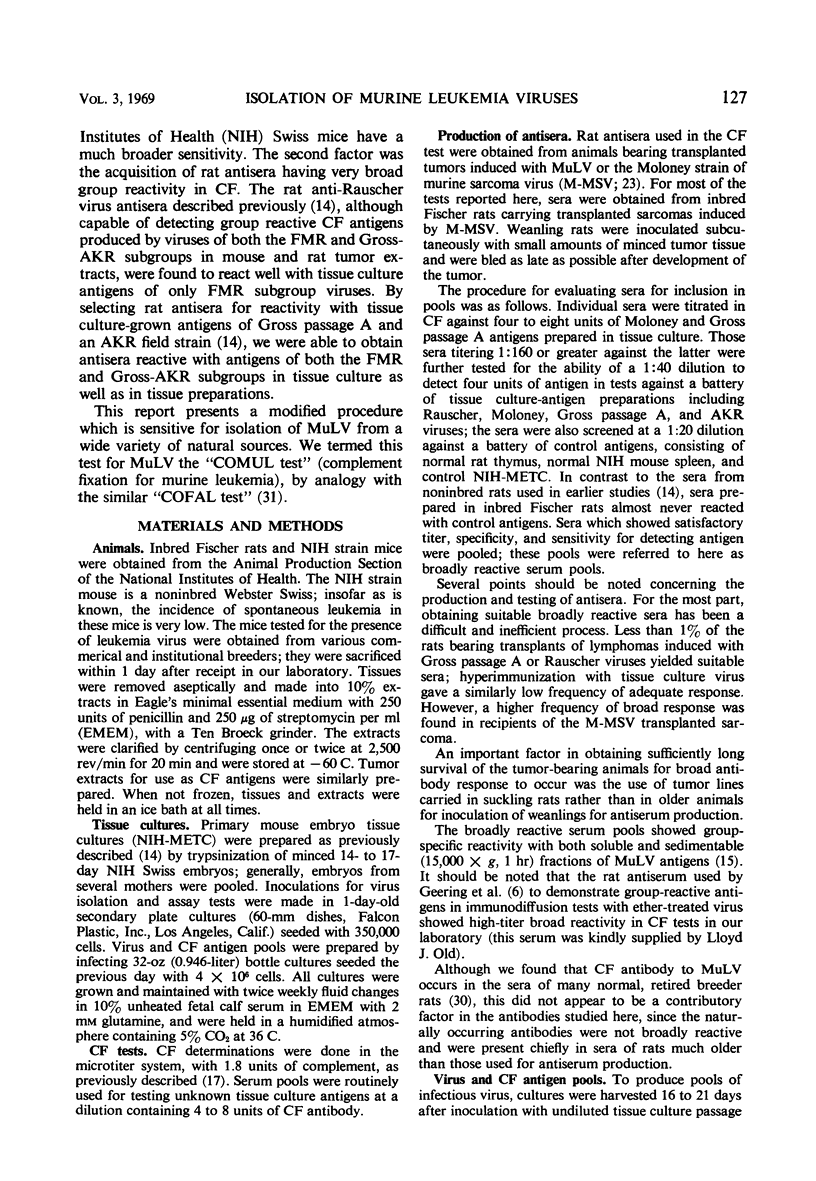
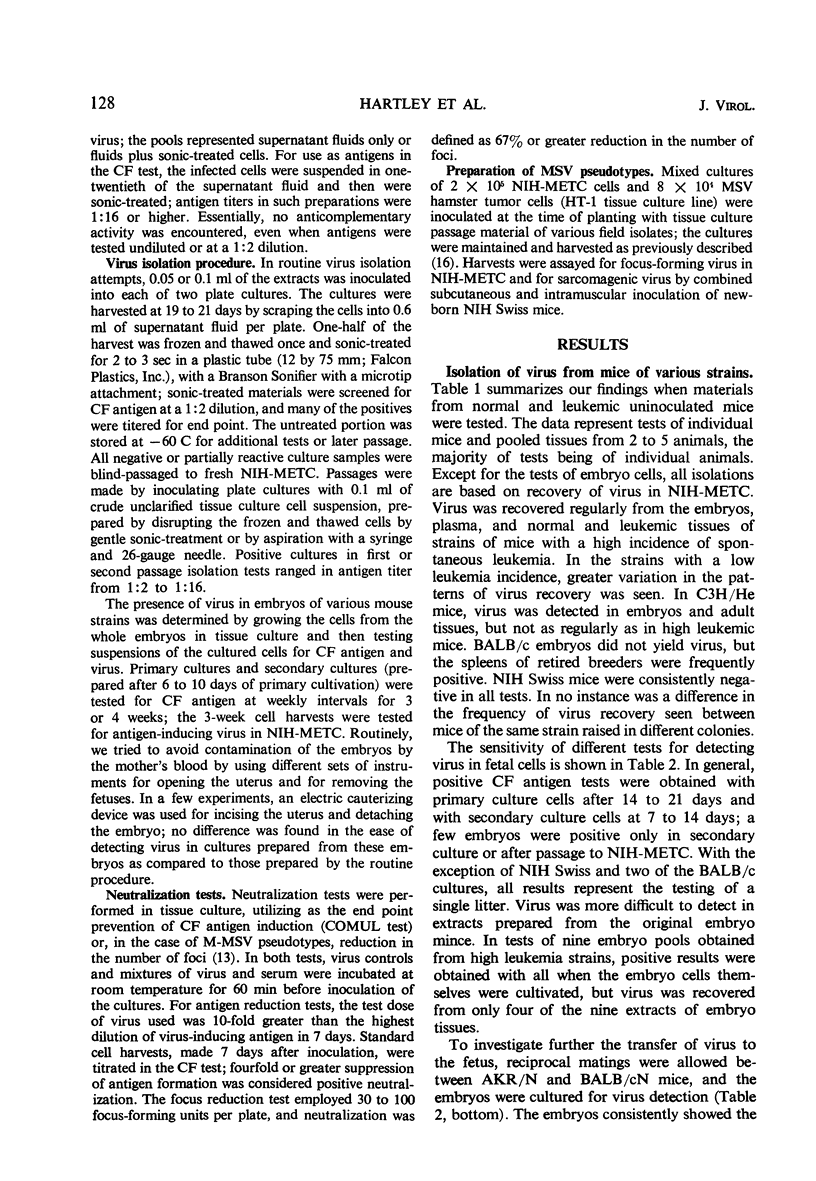
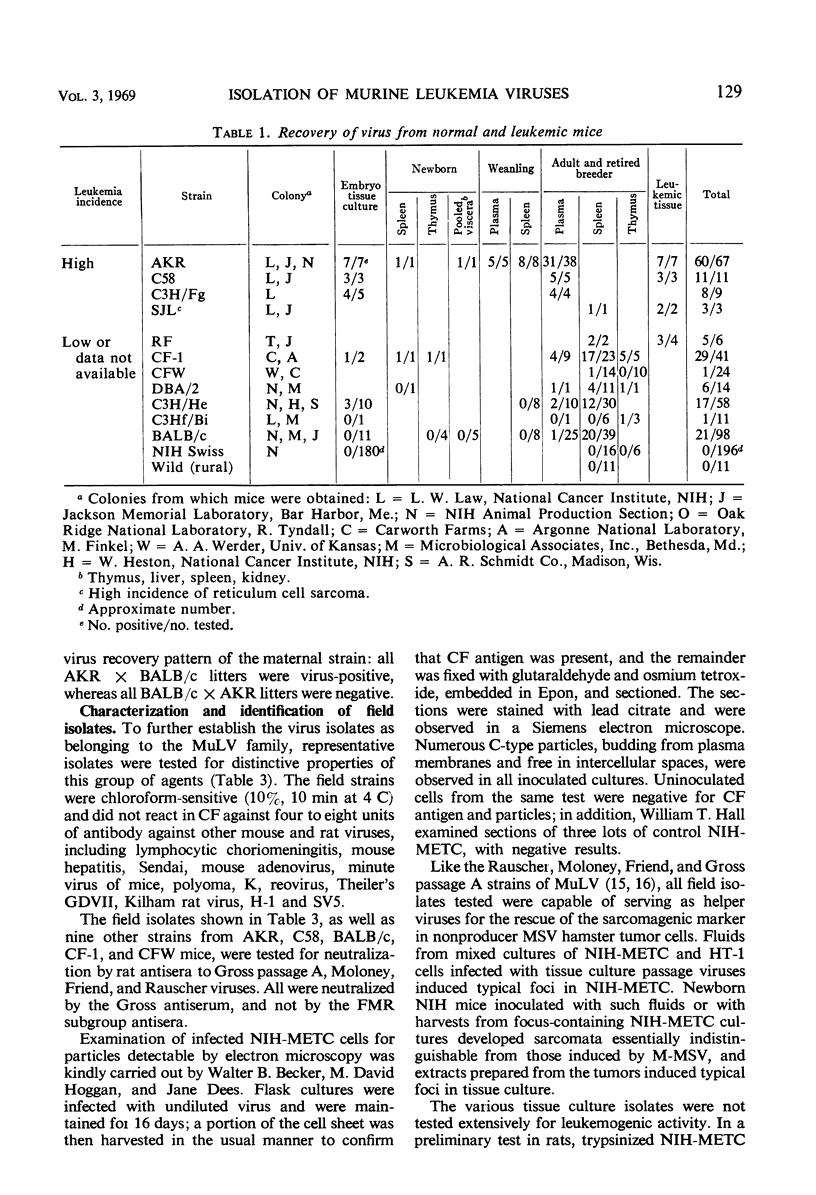
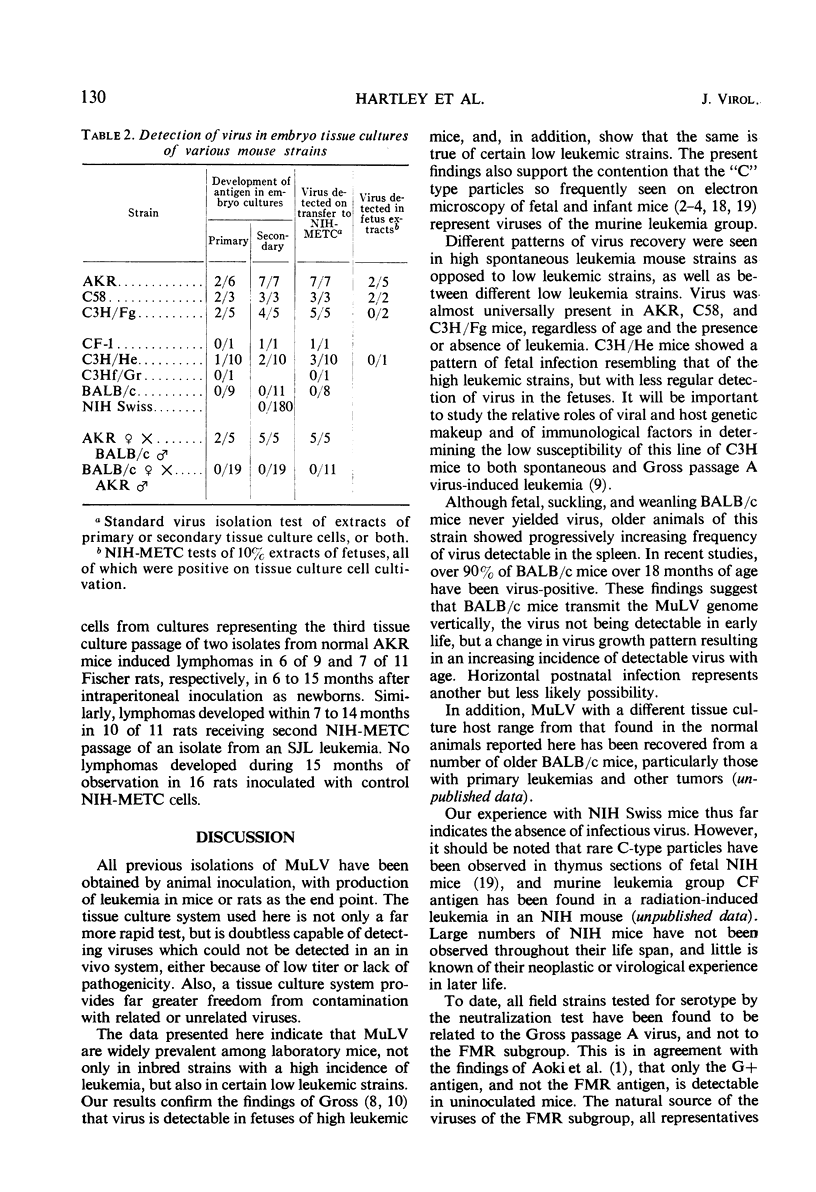
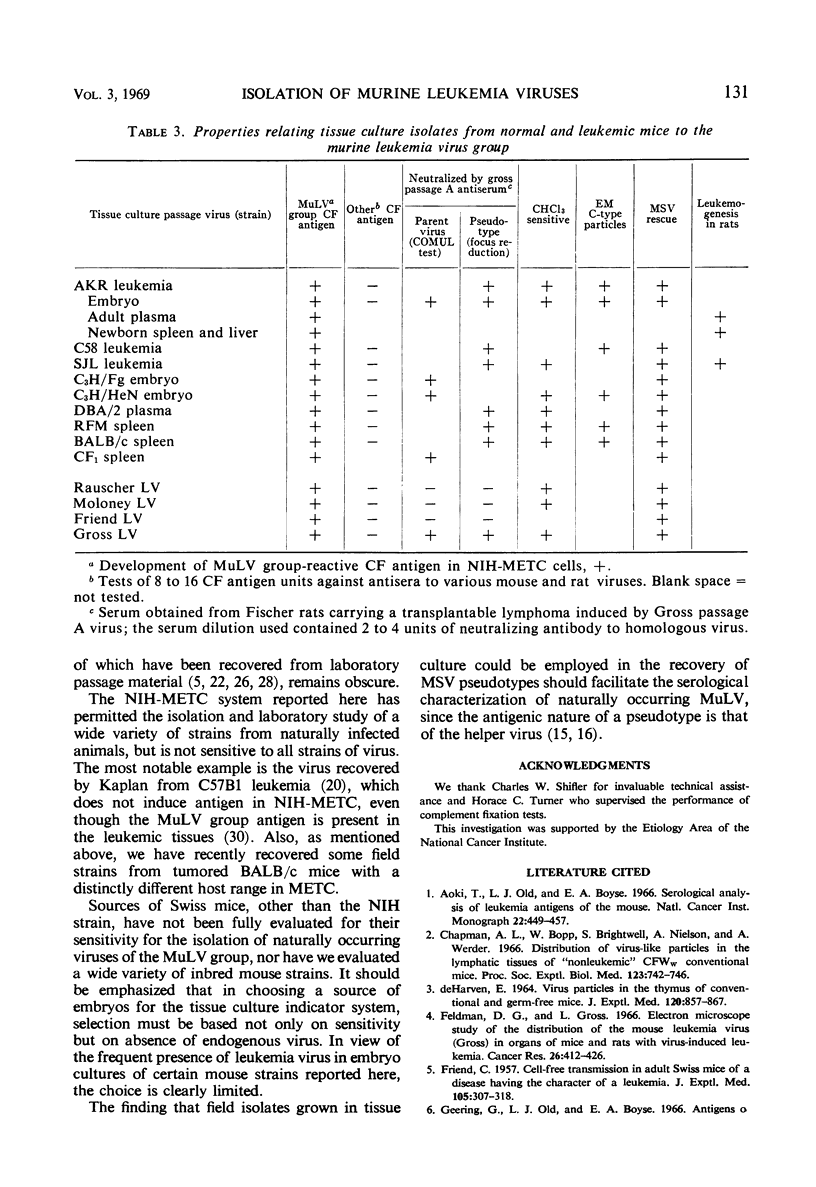
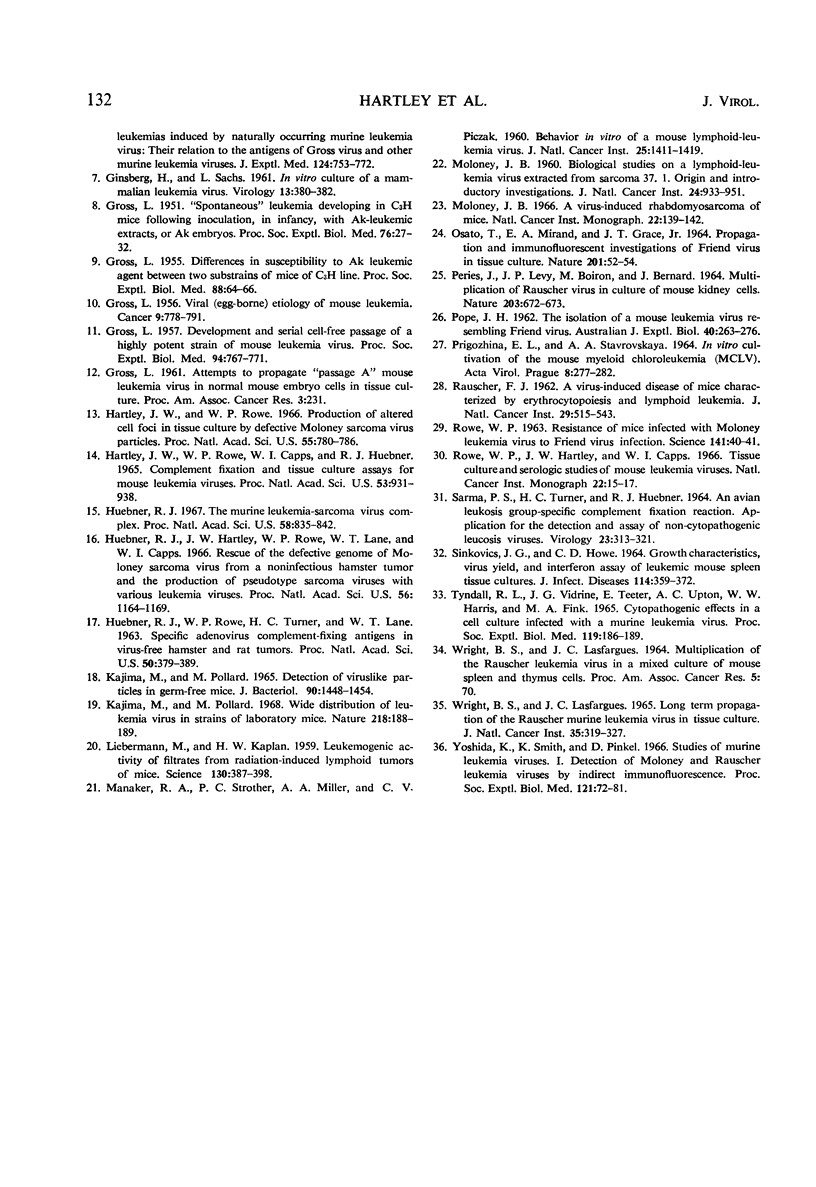
Selected References
These references are in PubMed. This may not be the complete list of references from this article.
- Aoki T., Old L. J., Boyse E. A. Serological analysis of leukemia antigens of the mouse. Natl Cancer Inst Monogr. 1966 Sep;22:449–457. [PubMed] [Google Scholar]
- Chapman A. L., Bopp W., Brightwell S., Nielson A., Werder A. Distribution of virus-like particles in the lymphatic tissues of "nonleukemic" CFW-w conventional mice. Proc Soc Exp Biol Med. 1966 Dec;123(3):742–746. doi: 10.3181/00379727-123-31592. [DOI] [PubMed] [Google Scholar]
- DEHARVEN E. VIRUS PARTICLES IN THE THYMUS OF CONVENTIONAL AND GERM-FREE MICE. J Exp Med. 1964 Nov 1;120:857–868. doi: 10.1084/jem.120.5.857. [DOI] [PMC free article] [PubMed] [Google Scholar]
- FRIEND C. Cell-free transmission in adult Swiss mice of a disease having the character of a leukemia. J Exp Med. 1957 Apr 1;105(4):307–318. doi: 10.1084/jem.105.4.307. [DOI] [PMC free article] [PubMed] [Google Scholar]
- Feldman D. G., Gross L. Electron microscopic study of the distribution of the mouse leukemia virus (gross) in organs of mice and rats with virus-induced leukemia. Cancer Res. 1966 Mar;26(3):412–426. [PubMed] [Google Scholar]
- GINSBURG H., SACHS L. In vitro culture of a mammalian leukemia virus. Virology. 1961 Mar;13:380–382. doi: 10.1016/0042-6822(61)90165-9. [DOI] [PubMed] [Google Scholar]
- GROSS L. "Spontaneous" leukemia developing in C3H mice following inoculation in infancy, with AK-leukemic extracts, or AK-embrvos. Proc Soc Exp Biol Med. 1951 Jan;76(1):27–32. [PubMed] [Google Scholar]
- GROSS L. Development and serial cellfree passage of a highly potent strain of mouse leukemia virus. Proc Soc Exp Biol Med. 1957 Apr;94(4):767–771. doi: 10.3181/00379727-94-23080. [DOI] [PubMed] [Google Scholar]
- GROSS L. Difference in susceptibility to Ak leukemic agent between two substrains of mice of C3H line. Proc Soc Exp Biol Med. 1955 Jan;88(1):64–66. doi: 10.3181/00379727-88-21493. [DOI] [PubMed] [Google Scholar]
- GROSS L. Viral egg-borne etiology of mouse leukemia; filtered extracts from leukemic C58 mice, causing leukemia (or parotid tumors) after inoculation into newborn C57 brown or C3H mice. Cancer. 1956 Jul-Aug;9(4):778–791. doi: 10.1002/1097-0142(195607/08)9:4<778::aid-cncr2820090428>3.0.co;2-z. [DOI] [PubMed] [Google Scholar]
- HUEBNER R. J., ROWE W. P., TURNER H. C., LANE W. T. SPECIFIC ADENOVIRUS COMPLEMENT-FIXING ANTIGENS IN VIRUS-FREE HAMSTER AND RAT TUMORS. Proc Natl Acad Sci U S A. 1963 Aug;50:379–389. doi: 10.1073/pnas.50.2.379. [DOI] [PMC free article] [PubMed] [Google Scholar]
- Hartley J. W., Rowe W. P., Capps W. I., Huebner R. J. Complement fixation and tissue culture assays for mouse leukemia viruses. Proc Natl Acad Sci U S A. 1965 May;53(5):931–938. doi: 10.1073/pnas.53.5.931. [DOI] [PMC free article] [PubMed] [Google Scholar]
- Hartley J. W., Rowe W. P. Production of altered cell foci in tissue culture by defective Moloney sarcoma virus particles. Proc Natl Acad Sci U S A. 1966 Apr;55(4):780–786. doi: 10.1073/pnas.55.4.780. [DOI] [PMC free article] [PubMed] [Google Scholar]
- Huebner R. J., Hartley J. W., Rowe W. P., Lane W. T., Capps W. I. Rescue of the defective genome of Moloney sarcoma virus from a noninfectious hamster tumor and the production of pseudotype sarcoma viruses with various murine leukemia viruses. Proc Natl Acad Sci U S A. 1966 Oct;56(4):1164–1169. doi: 10.1073/pnas.56.4.1164. [DOI] [PMC free article] [PubMed] [Google Scholar]
- Huebner R. J. The murine leukemia-sarcoma virus complex. Proc Natl Acad Sci U S A. 1967 Sep;58(3):835–842. doi: 10.1073/pnas.58.3.835. [DOI] [PMC free article] [PubMed] [Google Scholar]
- Kajima M., Pollard M. Detection of viruslike particles in germ-free mice. J Bacteriol. 1965 Nov;90(5):1448–1454. doi: 10.1128/jb.90.5.1448-1454.1965. [DOI] [PMC free article] [PubMed] [Google Scholar]
- Kajima M., Pollard M. Wide distribution of leukaemia virus in strains of laboratory mice. Nature. 1968 Apr 13;218(5137):188–189. doi: 10.1038/218188a0. [DOI] [PubMed] [Google Scholar]
- LIEBERMAN M., KAPLAN H. S. Leukemogenic activity of filtrates from radiation-induced lymphoid tumors of mice. Science. 1959 Aug 14;130(3372):387–388. doi: 10.1126/science.130.3372.387. [DOI] [PubMed] [Google Scholar]
- MANAKER R. A., STROTHER P. C., MILLER A. A., PICZAK C. V. Behavior in vitro of a mose lymphoid-leukemia virus. J Natl Cancer Inst. 1960 Dec;25:1411–1418. [PubMed] [Google Scholar]
- MOLONEY J. B. Biological studies on a lymphoid-leukemia virus extracted from sarcoma 37. I. Origin and introductory investigations. J Natl Cancer Inst. 1960 Apr;24:933–951. [PubMed] [Google Scholar]
- Moloney J. B. A virus-induced rhabdomyosarcoma of mice. Natl Cancer Inst Monogr. 1966 Sep;22:139–142. [PubMed] [Google Scholar]
- OSATO T., MIRAND E. A., GRACE J. T., Jr PROPAGATION AND IMMUNOFLUORESCENT INVESTIGATIONS OF FRIEND VIRUS IN TISSUE CULTURE. Nature. 1964 Jan 4;201:52–54. doi: 10.1038/201052a0. [DOI] [PubMed] [Google Scholar]
- PERIES J., LEVY J. P., BOIRON M., BERNARD J. MULTIPLICATION OF RAUSCHER VIRUS IN CULTURES OF MOUSE KIDNEY CELLS. Nature. 1964 Aug 8;203:672–673. doi: 10.1038/203672a0. [DOI] [PubMed] [Google Scholar]
- POPE J. H. The isolation of a mouse leukaemia virus resembling Friend virus. Aust J Exp Biol Med Sci. 1962 Aug;40:263–276. doi: 10.1038/icb.1962.30. [DOI] [PubMed] [Google Scholar]
- PRIGOZHINA E. L., STAVROVSKAYA A. A. IN VITRO CULTIVATION OF THE MOUSE MYELOID CHLOROLEUKAEMIA VIRUS. Acta Virol. 1964 May;8:277–282. [PubMed] [Google Scholar]
- RAUSCHER F. J. A virus-induced disease of mice characterized by erythrocytopoiesis and lymphoid leukemia. J Natl Cancer Inst. 1962 Sep;29:515–543. [PubMed] [Google Scholar]
- ROWE W. P. Resistance of mice infected with Moloney leukemia virus to Friend virus infection. Science. 1963 Jul 5;141(3575):40–41. doi: 10.1126/science.141.3575.40. [DOI] [PubMed] [Google Scholar]
- Rowe W. P., Hartley J. W., Capps W. I. Tissue culture and serologic studies of mouse leukemia viruses. Natl Cancer Inst Monogr. 1966 Sep;22:15–19. [PubMed] [Google Scholar]
- SARMA P. S., TURNER H. C., HUEBNER R. J. AN AVIAN LEUCOSIS GROUP-SPECIFIC COMPLEMENT FIXATION REACTION. APPLICATION FOR THE DETECTION AND ASSAY OF NON-CYTOPATHOGENIC LEUCOSIS VIRUSES. Virology. 1964 Jul;23:313–321. doi: 10.1016/0042-6822(64)90253-3. [DOI] [PubMed] [Google Scholar]
- SINKOVICS J. G., HOWE C. D. GROWTH CHARACTERISTICS, VIRUS YIELD, AND INTERFERON ASSAY OF LEUKEMIC MOUSE SPLEEN TISSUE CULTURES. J Infect Dis. 1964 Oct;114:359–372. doi: 10.1093/infdis/114.4.359. [DOI] [PubMed] [Google Scholar]
- TYNDALL R. L., VIDRINE J. G., TEETER E., UPTON A. C., HARRIS W. W., FINK M. A. CYTOPATHOGENIC EFFECTS IN A CELL CULTURE INFECTED WITH A MURINE LEUKEMIA VIRUS. Proc Soc Exp Biol Med. 1965 May;119:186–189. doi: 10.3181/00379727-119-30132. [DOI] [PubMed] [Google Scholar]
- Wright B. S., Lasfargues J. C. Long-term propagation of the Rauscher murine leukemia virus in tissue culture. J Natl Cancer Inst. 1965 Aug;35(2):319–327. [PubMed] [Google Scholar]
- Yoshida K., Smith K. L., Pinkel D. Studies of murine leukemia viruses. I. Detection of Moloney and Rauscher leukemia viruses by indirect immunofluorescence. Proc Soc Exp Biol Med. 1966 Jan;121(1):72–81. doi: 10.3181/00379727-121-30701. [DOI] [PubMed] [Google Scholar]


